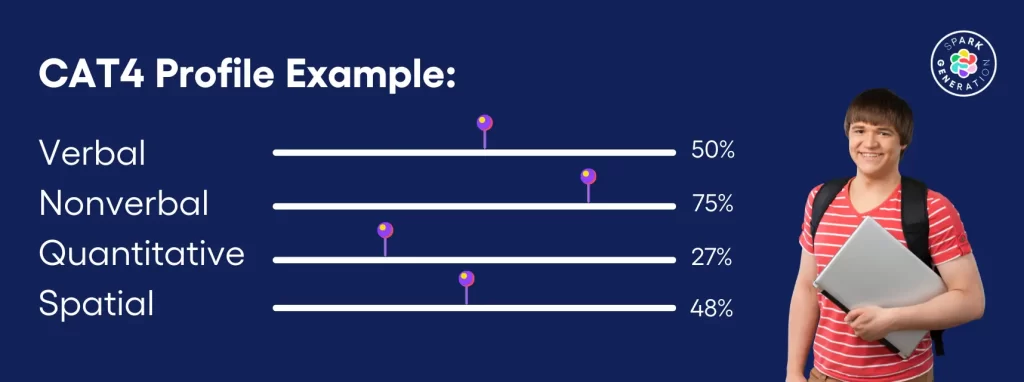In an educational landscape that is becoming increasingly personalised, the Cognitive Abilities Test Fourth Edition (CAT4) stands out as a crucial tool for understanding student learning profiles, especially in high school settings.
What is the CAT4?
The CAT4 is the UK and Ireland’s most widely used test of reasoning abilities, standardised on a large sample size and verified annually to ensure accuracy and reliability.
It measures four key types of reasoning ability known to impact learning and academic achievement significantly:
- verbal (the use of language)
- non-verbal (the ability to understand and analyse visual information)
- quantitative (numerical reasoning)
- and spatial (the ability to think about objects in three dimensions)
By assessing these areas, the CAT4 provides a rounded profile of a student’s cognitive capabilities beyond what can be observed in classroom behaviour or academic performance alone.
Why is CAT4 Useful in High School?
Identifying Learning Preferences and Needs
High school is a critical phase in a student’s educational journey, characterised by more specialised subject choices and preparation for further education and careers.
Understanding a student’s CAT4 profile helps educators and parents identify the most suitable learning paths, subject areas, and even potential career directions that align with the student’s abilities and preferences.
Tailoring Educational Strategies
The insight gained from CAT4 assessments enables educators to customise teaching methods and resources to better suit each student’s learning style.
For students showing a strong inclination towards visual and spatial reasoning, for example, incorporating more graphical and interactive learning materials can enhance engagement and understanding. Similarly, students with high verbal reasoning abilities might benefit from activities emphasising critical reading and writing.
Supporting Personal and Academic Growth
The detailed analysis provided by CAT4 assessments helps in setting realistic and challenging educational goals.
By highlighting areas of strength, students can be encouraged to pursue excellence and leadership in subjects and activities where they naturally excel.
Conversely, identifying areas that require development allows for targeted interventions, minimising the risk of students becoming disengaged due to unaddressed learning challenges.
Enhancing Transition Planning
Transitions—whether to a new school level, higher education, or the workforce—are significant milestones for high school students.
CAT4 results can inform these transitions, ensuring that students are prepared for the academic demands and learning environments they will encounter next.
Understanding their cognitive profiles can also empower students to make informed decisions about their future studies and careers.
Support for Diverse Learning Needs
The CAT4 is instrumental in identifying students with specific learning needs, including those who may be underperforming or experiencing barriers to learning.
By uncovering these insights early, educators and parents can implement targeted interventions to support every student’s learning journey effectively.
Understanding Your CAT4 Results
The CAT4 assesses students’ abilities in four key areas: verbal, non-verbal, quantitative, and spatial reasoning.
This comprehensive approach provides a rounded profile of cognitive abilities, revealing hidden potentials and areas that may require further support.
Here’s a closer look at what each area signifies and how it relates to learning styles:
1. Verbal Reasoning
Verbal reasoning is about how well students understand and process language. It encompasses:
- reading
- vocabulary
- and the ability to understand and critique arguments
Students with high verbal reasoning skills often excel in debates, enjoy reading, and are skilled at writing and presenting arguments. Conversely, those who find verbal tasks challenging may benefit from targeted support to enhance their reading comprehension and language skills.
2. Non-Verbal Reasoning
This area measures the student’s ability to understand and analyse visual information, solve puzzles, and reason with shapes rather than words.
Students strong in non-verbal reasoning excel in solving complex problems that require visual-spatial understanding, such as puzzles and scientific problems.
Those less confident might need support in activities that require abstract problem-solving and visual-spatial tasks.
3. Quantitative Reasoning
Quantitative reasoning focuses on numerical ability, encompassing
- arithmetic
- pattern recognition
- and problem-solving with numbers
Students who shine in this area often find mathematics and related subjects engaging and are good at identifying patterns in data.
Students facing challenges in quantitative reasoning might experience math anxiety and could benefit from strategies aimed at building confidence and competence in math.
4. Spatial Reasoning
Spatial reasoning assesses the ability to think about objects in three dimensions and to visualise theoretical concepts.
Learners with strong spatial abilities are typically good at tasks requiring the manipulation of shapes, mechanical reasoning, and interpreting maps and graphs.
Those with less developed spatial reasoning skills may require extra help with subjects that involve a lot of visual-spatial work, such as geometry and some science subjects.
Interpreting Your Profile Summary & CAT4 Results
The CAT4 report includes a profile summary that categorises students into one of several learner profiles based on their scores across the four domains.
These profiles help in understanding the balance of a student’s abilities, highlighting their strongest areas and those that may require additional support. Some of the profiles mentioned include:
- High General Ability: Indicates strong performance across all areas, suggesting a versatile learner.
- Spatial Bias: Reflects stronger performance in spatial reasoning compared to other areas.
- Verbal Bias: Indicates a preference for and strength in verbal reasoning.
- Quantitative Bias: Shows strength in quantitative reasoning.
- Non-Verbal Bias: Highlights a student’s ability in non-verbal reasoning tasks.

Tailoring Education with CAT4 at Spark Generation
At Spark Generation, we leverage CAT4 results to craft personalised learning experiences.
Recognising that each student has a unique set of abilities, we aim to foster an educational environment that encourages growth, challenges students appropriately, and supports areas needing development.
CAT4 is not just a test. It’s a foundational tool in modern education that recognises the diversity of student intelligence and learning styles.
By incorporating CAT4 assessments into our educational process, we like to think that we are offering educational experiences that best match our students’ abilities and talents.
We ensure that every student has the opportunity to understand their learning profile, maximise their potential, and navigate their educational journey with confidence.
This holistic approach to learning is essential for preparing students not only for academic success but also for lifelong achievement and satisfaction in their chosen paths.
Curious about your own CAT4 profile & results?
You might be amazed at what you find out! And besides that, the results might help you bring to life the most suitable and exciting learning experience you have ever dreamed about!
At Spark Generation, we are dedicated to utilising the CAT4 to its fullest potential, ensuring that every student embarks on a learning journey that is as rewarding as it is enlightening.
Our goal is not just to educate. But to inspire a generation of learners to discover and harness their unique strengths.
For more details on how we integrate CAT4 into our educational approach or to schedule a test, explore the resources available on our website or contact us directly.
FAQ CAT4 Results: What type of learner are you?
-
How does the CAT4 help students in choosing the right subjects or courses?
CAT4 provides insights into a student’s natural strengths and preferences. This enables them to make informed decisions about which subjects or courses might be most suitable and enjoyable for them.
-
Can a student’s CAT4 results change over time?
While core cognitive abilities tend to be stable, targeted learning and development activities can enhance specific areas. The CAT4 test serves as a snapshot, guiding immediate educational strategies.
-
How often should students take the CAT4?
The CAT4 is typically administered at key educational transitions to provide the most relevant information for educational planning.
However, consulting with educational professionals at Spark Generation can help determine the best timing.




